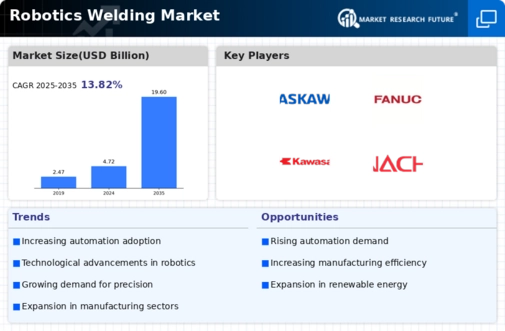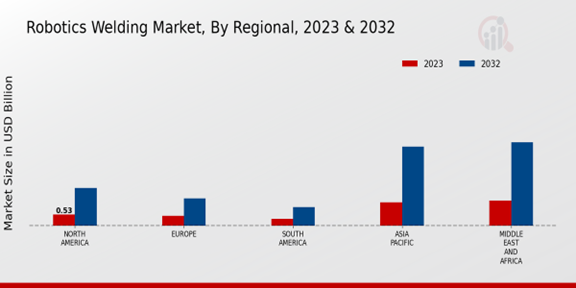Labor Shortages
The Global Robotics Welding Market Industry is significantly influenced by labor shortages, particularly in skilled welding positions. As the workforce ages and fewer individuals enter the trade, companies are turning to robotic solutions to fill the gap. Robotics can perform repetitive tasks with high precision, alleviating the pressure on human workers and allowing them to focus on more complex activities. This shift is particularly evident in regions facing acute labor shortages, where businesses are investing in robotic welding systems to maintain production levels. Consequently, this trend is likely to propel the market towards an estimated value of 19.6 USD Billion by 2035.
Market Growth Projections
The Global Robotics Welding Market Industry is projected to experience substantial growth over the next decade, with estimates indicating a rise from 4.72 USD Billion in 2024 to 19.6 USD Billion by 2035. This trajectory suggests a compound annual growth rate of 13.82% from 2025 to 2035, reflecting the increasing adoption of robotic welding solutions across various sectors. The market dynamics are influenced by factors such as technological advancements, rising demand for automation, and labor shortages, which collectively contribute to the robust growth outlook for the industry.
Technological Advancements
The Global Robotics Welding Market Industry is experiencing rapid technological advancements that enhance the efficiency and precision of welding processes. Innovations such as artificial intelligence and machine learning are being integrated into robotic systems, allowing for real-time adjustments and improved weld quality. For instance, companies are adopting advanced sensors and vision systems that enable robots to adapt to varying material conditions. This trend is likely to drive market growth, as businesses seek to optimize production and reduce waste. As a result, the market is projected to reach 4.72 USD Billion in 2024, reflecting the increasing reliance on sophisticated welding technologies.
Increasing Quality Standards
The Global Robotics Welding Market Industry is also driven by the increasing quality standards imposed by regulatory bodies across various sectors. Industries such as aerospace and automotive are subject to stringent quality control measures, necessitating the adoption of advanced welding technologies. Robotic welding systems offer enhanced consistency and repeatability, ensuring that welds meet or exceed these rigorous standards. For instance, manufacturers are utilizing robotic systems to achieve precise welds that comply with international quality certifications. This emphasis on quality is expected to further stimulate market growth, as companies invest in robotics to enhance their competitive edge.
Rising Demand for Automation
The Global Robotics Welding Market Industry is witnessing a surge in demand for automation across various sectors, including automotive, aerospace, and construction. As industries strive for higher productivity and reduced labor costs, robotic welding solutions are becoming increasingly attractive. Automation not only enhances production rates but also improves safety by minimizing human exposure to hazardous environments. For example, automotive manufacturers are increasingly implementing robotic welding systems to streamline assembly lines. This growing trend is expected to contribute to a compound annual growth rate of 13.82% from 2025 to 2035, indicating a robust future for automated welding solutions.
Global Expansion of Manufacturing
The Global Robotics Welding Market Industry is benefiting from the global expansion of manufacturing activities, particularly in emerging economies. Countries in Asia-Pacific and Latin America are increasingly investing in manufacturing infrastructure, leading to a heightened demand for efficient welding solutions. As these regions develop their industrial capabilities, the adoption of robotic welding technologies is becoming a priority to enhance productivity and competitiveness. For example, manufacturers in India and Brazil are integrating robotic systems to modernize their operations. This trend is anticipated to drive significant growth in the market, aligning with the overall trajectory of global manufacturing expansion.






